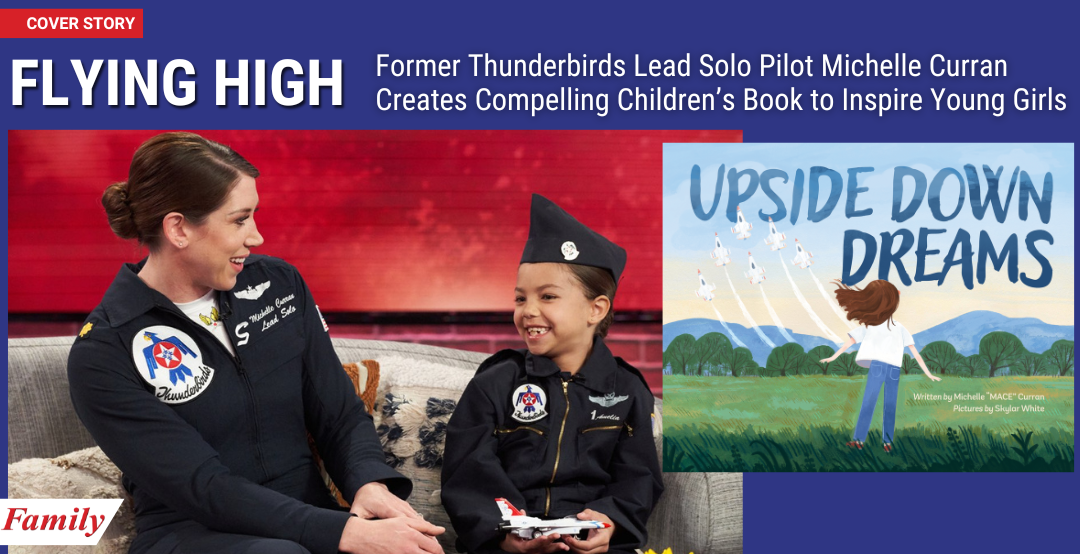Former Thunderbirds Lead Solo Pilot Michelle Curran Creates Compelling Children’s Book To Inspire Young Girls
By Donna Boyle Schwartz
Many young girls have big dreams about the future, and as a child, Michelle Curran was no different: Her “big dream” was to become a fighter pilot, a dream that she transformed into a reality, becoming the lead solo pilot for the legendary Air Force Thunderbirds.
Curran, also known by her call sign “MACE,” is now hoping to inspire the next generation of young fighter pilots with the launch of her new children’s book Upside Down Dreams, published in June by End Game Press.
“My greatest hope is that this story will open children’s eyes to all that is possible for them,” Curran declares. “I hope that young girls specifically will walk away with an increased hope for what they can accomplish in this world and give them a vision for what is possible for them.
“The importance of having role models we can relate to shouldn’t be underestimated,” she continues. “For a child, simply seeing someone who looks like them doing something they didn’t believe they could do can completely change their perspective. My audience is children ages 4-7. The book has themes centered around the challenges a little girl faces when her dream is focused on something seen as male-dominated. However, both boys and girls will enjoy the story of inspiring aviation and heartwarming family bonds. I think kids who read the book or have it read to them will feel excited about the adventure of military aviation and empowered by the main character, Lilly’s, story.”
Curran served on active duty in the Air Force for 13 years, stationed at Columbus AFB, MS; Luke AFB, AZ; Misawa AB, Japan; NAS JRB Fort Worth, TX; and Nellis AFB, NV. Originally from a small town in northern Wisconsin, she entered the military as a way to pay for college, but then it grew into an exciting career. “The opportunities that the Air Force gave me were well beyond what I could have dreamed of,” she relates. “I got to travel the world, push myself far further than I likely would have otherwise, and work with some of the most talented people in the world.
“I left active duty in April of 2022 and immediately began creating my own business,” she adds. “This includes keynote speaking, leading workshops, consulting, and writing. I saw the value in my unique experiences during my service and that they could act as a conduit to teach others. My passion is to inspire individuals and teams to make bold decisions, empower them to face fears and help them find inner strength to reach their true potential.”
Writing Upside Down Dreams was a “passion project” for her. “I hope to see it in the hands of as many kids as possible,” she comments. “I hope the children that read this story realize the opportunities out there for them in aviation, but beyond that, I hope they are empowered to realize how much is possible for them. I hate to see people sell themselves short because of artificial barriers that society constructs or that they construct through limiting thoughts.”
Curran came up with the idea for the book in 2019, during her first air show season with the Thunderbirds when she visited the Smithsonian Air and Space Museum. “Their bookstore had several children’s books, but few had female characters as pilots,” she recalls. “I decided then that I eventually wanted to write a book about a little girl who wanted to be a fighter pilot.
“The specific story in the book is inspired by the countless interactions I had from the pilot’s perspective, meeting with kids at various events,” she adds. “I had one little girl share a nearly identical interaction with a peer to the one described in the book. She was devastated by the idea that her dream might not be possible. That one conversation with her showed her it was possible, and her demeanor completely changed. I hope the book can do for other kids what that conversation did for her.”
Curran herself has overcome many challenges, both in her military career and transitioning to civilian life. “I went through a period early in my career when I was a brand new fighter pilot where I really struggled,” she points out. “I felt completely in over my head and was sure I didn’t deserve to be there. It got to the point where I felt completely isolated from my peers and my family. I was stationed overseas and had this idea that I had to prove myself and not show any weakness. I didn’t think I could show up authentically, and putting on a fake type-A tough persona was exhausting. That led to me keeping a wall up, preventing any deeper connections with people, and avoiding asking for help when I could have used it.”
Writing and publishing the book also was a difficult path. “I had no idea how the publishing world worked,” she notes. “The first challenge in a children’s picture book is getting the story across in so few words. After several revisions, I got there. Another challenge is that the author is only half the equation. You also must find an illustrator who can bring the story to life. It took over three years from the initial idea to find a publisher willing to work with me and match me with an illustrator. In between there, I received many no’s or no replies from literary agents.
“I think this journey is such a great example of how things take time and to be persistent,” she adds. “The book ended up on the back burner many times, but I always came back to move it forward in small ways when I had the time. It is also a great example of how you can figure things out as you go, even when you don’t feel 100% ready to start them at the beginning.”
Curran believes her experiences adjusting to civilian life are common among veterans. “There can be this feeling that no one understands you or what you have been through,” she points out. “Especially once military members decide to separate or retire, their whole life has revolved around the military and the culture that comes with it. It can feel uncomfortable to put yourself out there and find ways to connect with people who don’t have a military background. It’s easy to discount their experiences and assume you have nothing in common.
“I talk a lot about the power of vulnerability and the rewards of being bold,” she adds. “You do have to tap into both of those things when you transition. You have to let people in to make new connections, which can feel scary. There is a period right after you transition where you have a great opportunity to find new passions, meet new people and find your new purpose. You’re going to have to put yourself out there a bit and keep an open mind to do that. “
Curran also helps run a non-profit, Veterans’ Outdoor Advocacy Group (VOAG), advocating for the use of outdoor therapy as an adjunct treatment for veterans struggling with mental health. “Working with other veterans at VOAG has also re-created the community I left behind upon leaving active duty,” she notes. “It’s been a fantastic organization to be a part of and a fun way to affect the overall veteran community positively.
“Transitioning into the civilian workforce has allowed me to connect with many other veterans and active-duty troops with diverse backgrounds,” she explains. “I’ve realized we all share common challenges upon leaving active duty. Many veterans lose their sense of purpose and mission-driven focus and feel like they’ve lost their communities. Experiencing this has given me a better understanding of why it is so challenging for so many.
“I’ve also noticed that many veterans don’t understand how valuable the skills they learned in the military are and how to translate them to the civilian sector,” she adds. “A lot of us served in very tactical-specific careers that don’t have an apparent civilian equivalent. For example, I had a fellow fighter pilot say his only option was to fly commercially because he only knew how to fly airplanes. I regularly challenge other veterans to dig deeper into their experiences. Most have very sought-after skills like teamwork, grit, composure under pressure, tenacity, and discipline that will serve them well. All these soft skills have translated into my post military life and allowed me to be successful as an entrepreneur.”
Curran also works with Air Force recruiting offices to expose children and young adults to the opportunities that military aviation can offer them. “Coming from the Thunderbirds, this was a natural fit since the two organizations’ missions align so closely,” she says. “I’ve shared my story with JROTC, ROTC, and many other groups to help inspire them to explore the military and to go after their big dreams.”
For more information or to purchase Upside Down Dreams, visit the publisher’s website here.



